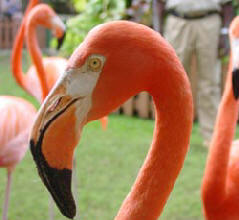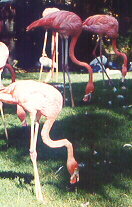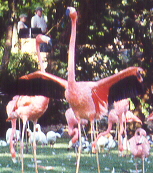
The Caribbean Flamingo has great hearing, which is important because they can detect if their colony is in danger. However, they have poor taste, smell, and night vision. Their vision is better than a human's though. Flamingos have great color perception and in captivity they are able to recognize the uniform of the zookeepers among the visitors.
Adaptations


Flamingos live in high salt concentrated environments and if they consume any excess salt while drinking water it needs to be expelled. In order to do so, salt is excreted through salt glands that are located above the eyes. The glands then drain to the nasal cavity and the salt is released through the nostrils. In captivity these salt glands are inactive because of the decreased level of salt in the environment. Flamingos also have really tough skin on their legs, which allows them to live in alkaline soda lakes. If a human were to go into a soda lake, their skin would be removed in a matter of seconds!


Flamingos have long legs with webbed feet to wade in the water and a long neck to reach food deep underwater. Their curved bill also helps them filter feed on the bottom. In the filter feeding process flamingo takes in water, which is released, but keep all of the organisms that it has trapped in its lamellae (comb-like structures, covered with fine hairs). The food is drawn to the back of the mouth at the same time more water is drawn in. For a more detailed description of filter feeding, go to Nutrition.


Flamingos are able to stand on one leg. This allows the flamingo to keep its curled foot warm and decrease its surface area to volume ratio, which means that less area is exposed to the environment and less heat is given off.

Flamingos are able to walk around on their webbed feet, they can also fly, and swim. When the water is beyond wading depth, flamingos use their swimming ability to swim at the surface while feeding. When food is scarce flamingos may fly somewhere else, like during the wintering months, however flamingos are particularly non-migratory birds. Once in flight, flamingos fly with their head and neck out in front and their long legs trailing behind. They even have been known to fly 311-373 miles a night!